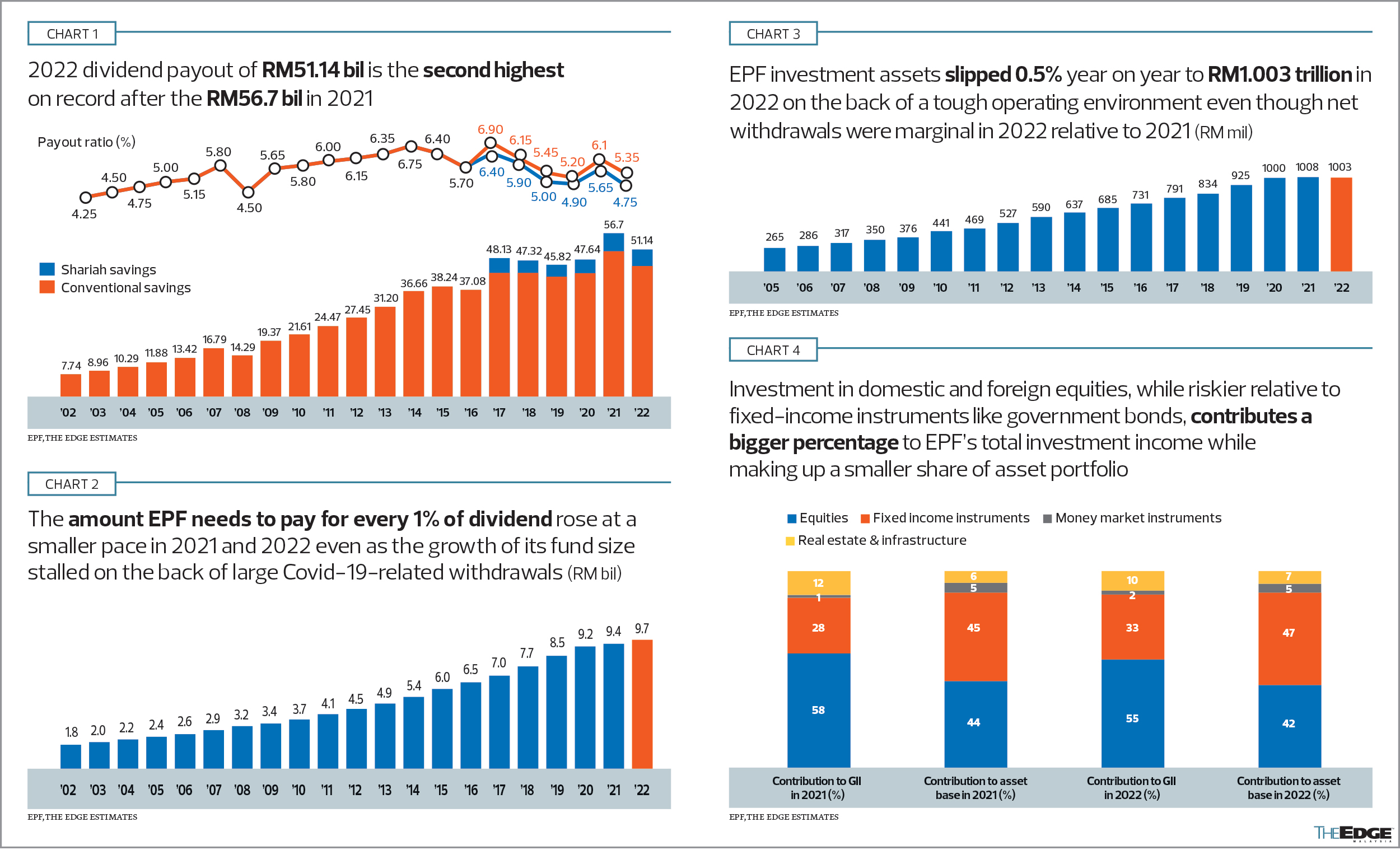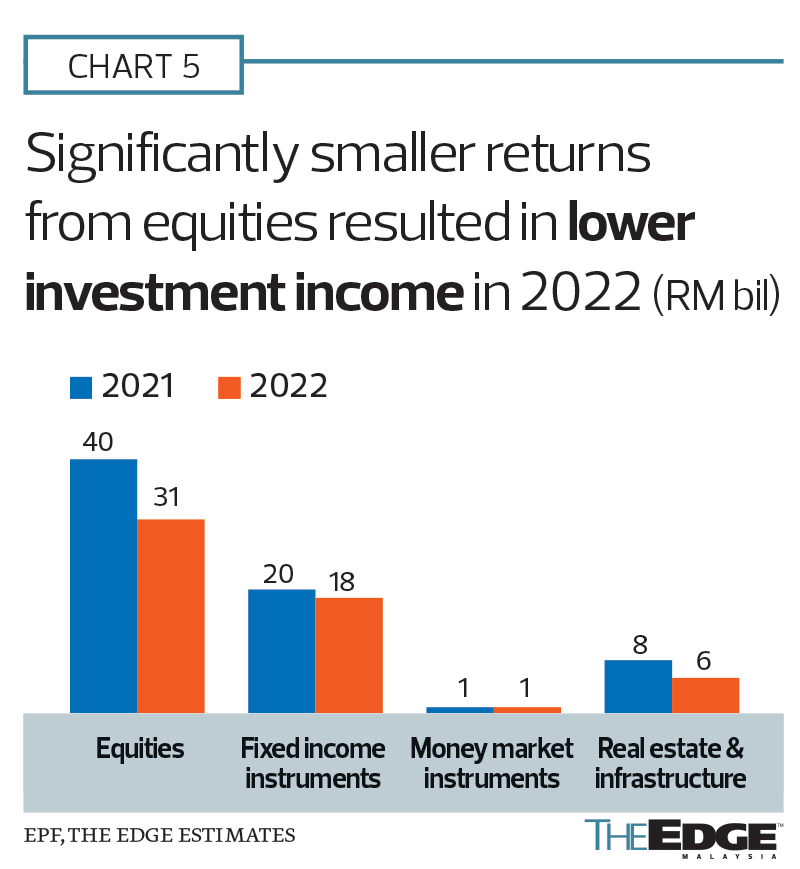
This article first appeared in The Edge Malaysia Weekly on March 13, 2023 - March 19, 2023
AS expected, the Employees Provident Fund (EPF) declared on March 4 a lower year-on-year (y-o-y) dividend rate for 2022. The 5.35% for conventional savings (SK) and 4.75% for shariah savings (SS) were respectable, even though they were below the 6.1% and 5.65% declared for 2021, considering the highly volatile investment climate last year across most asset classes as markets around the globe whipsawed in the face of a very hawkish US Federal Reserve that is not quite done with raising interest rates yet.
While the 5.35% dividend declared for conventional savings is lower than the 5.45% in 2019, the RM51.14 billion (RM45.44 billion for conventional savings and RM5.7 billion for shariah savings) paid out to more than 15 million EPF members is the second largest on record after the RM56.7 billion paid out last year for 2021 (see Chart 1).
The lower dividend rate for 2022 is also because the amount the EPF needed to pay every 1% of dividend had inched higher to RM9.7 billion from RM9.4 billion in 2021 (see Chart 2).
The RM56.7 billion paid out for 2021 would only have been enough to declare a dividend of 5.85% for 2022, our back-of-the-envelope calculations show — the reason The Edge had written in mid-December that EPF dividends for 2022 were likely to be lower y-o-y and between 5% and 5.5%. This was before Permodalan Nasional Bhd’s flagship fund Amanah Saham Bumiputera (ASB) paid a dividend of 4.6 sen (3.35 sen dividend + 1.25 sen bonus) for 2022, with an additional 0.5 sen paid only for the first 30,000 units (RM30,000) held to bring the total dividend to 5.1% for unitholders with smaller savings. (Calculations are done on a blended basis to gauge the performance of conventional savings, which make up the bulk of the EPF’s total portfolio.)
In short, this means the EPF would need to do better than 2022 to pay at least a 5% dividend for 2023, The Edge’s back-of-the-envelope calculations show. The challenge would be greater going forward, with improved employment numbers, as the economy recovers from the Covid-19 pandemic, during which an unprecedented amount of withdrawals slowed the growth of its fund size.
The EPF’s assets under management stayed above the RM1 trillion mark at end-2022, but slipped about 0.5% to RM1.003 trillion from RM1.008 trillion in 2021 (see Chart 3).
As noted by The Edge last year, the EPF — which booked its first net withdrawal in 20 years, of RM58.2 billion, in 2021 — again booked a small net withdrawal of RM3.2 billion in 2022, with the RM91 billion withdrawn by members (including RM44.6 billion in the special withdrawal in April and May 2022) exceeding the RM87.8 billion in contributions for that year.
Having said that, the EPF is still the sixth-largest retirement fund in Asia and the 15th-largest in the world by asset size.
Looking ahead, a lot will ride on how much the EPF nets from the performance of its equity portfolio, especially its foreign-listed equities.
Its return on investment (ROI) for foreign-listed equities was 9.27% in 2022, compared with 7.92% for the blended equity basket that collectively contributed 55%, or RM30.54 billion, to the EPF’s RM55.33 billion in gross investment income for 2022 while making up only 42% of total investment assets (see Chart 4).
Overall, foreign investments accounted for 45% of the EPF’s total gross investment income while making up only 36% of its investment assets in 2022. It is not immediately known how much a weaker ringgit contributed to the high ringgit-denominated returns. The provident fund, in a statement accompanying its results release, said its diversification into foreign assets and currencies allowed it to “realise additional gains with profits from non-ringgit sources” and had “added value to the retirement fund’s overall returns”.
Profits from equities in 2022, however, were lower y-o-y (see Chart 5). In 2021, equities accounted for RM40.06 billion, or 58.1% of the EPF’s total GII of RM68.89 billion, even though the asset class accounted for only 44% of its total portfolio. ROI was even higher at 8.96%, with foreign-listed equities achieving even higher returns of 10.44%, EPF data shows.
Fixed-income investments, which account for 47% of the EPF’s investment assets, contributed RM18.19 billion, or a third of the EPF’s gross investment income in 2022, with an ROI of 4.37% compared with 4.69% in 2021.
With less pressure on withdrawals, the EPF saw an improved ROI from money market instruments — which it keeps for liquidity management — at 3.48% in 2022 compared with 2.07% in 2021. Contributions to gross investment income were probably about RM100 million higher y-o-y at just above RM1 billion.
The EPF’s investment in real estate and infrastructure also saw a higher ROI y-o-y at 10.5% for 2022 compared with 6.53% in 2021. Real estate and infrastructure contributed about RM3 billion less to gross investment income in 2022 at RM5.6 billion, or 10% of gross investment income, compared with RM8.4 billion, or 12.2% of gross investment income, in 2021.
When announcing its 2022 results, EPF chairman Tan Sri Ahmad Badri Mohd Zahir attributed the fund’s performance to its “overarching strategy that emphasises long-term sustainability of investment and returns, in line with its Strategic Asset Allocation (SAA)”, noting that its “well-diversified portfolio and healthy liquidity helped reduced risk and enabled the fund to maintain investment assets above RM1 trillion and deliver respectable dividends for 2022”.
The strength of its SAA and investment managers will be further tested as Malaysia becomes an ageing society, especially with members accustomed to much higher returns than its target of at least 2.5% nominal dividend per year while beating inflation by 2% on a rolling three-year basis.
Save by subscribing to us for your print and/or digital copy.
P/S: The Edge is also available on Apple's App Store and Android's Google Play.
- EcoWorld to sell RM266m land, lease data centre to Google affiliate
- All 400 landed Park Homes of Gamuda Land's The Clove Phase 1 snapped up across three townships
- Nestlé Malaysia reports decade-low profit in 4Q; annual dividend drops to 15-year low
- Petronas’ FY2024 net profit falls 32% on softer energy prices, lower tax adjustments
- Affin Bank’s 4Q profit jumps over threefold on write-backs, proposes bonus issue
- Nestlé (Malaysia), Affin Bank, TM, IOI Corp, Padini, ITMAX, Leong Hup, AEON Co, Frontken, Pentamaster, Keyfield, Pekat, TNB, NEXG
- Nasdaq touches over one-month low after weak consumer sentiment data
- Tesla market value slips below US$1 tril as Europe sales sink
- US consumer confidence drops by most since 2021 on outlook
- Magnificent 7 dips into correction territory with Tesla lagging


